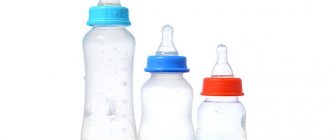07/29/2020 Reading time: 3 min 66423 0
The earliest date for starting complementary feeding is 4 months1. When exactly to introduce your baby to “regular food”, check with your pediatrician. Complementary foods cannot be introduced2:
- during illness,
— 3-5 days before and after vaccinations.
What is complementary feeding?
Complementary feeding is everything that a baby eats up to one year, except for mother's milk and infant formula1.
At what months can complementary foods be introduced?
Contrary to popular belief, a baby's intestines under 6 months of age are not ready to digest any food? In addition to breast milk or a special formula, the body of an artificial baby quickly adapts to the processing of new products.
The age for expanding the children's menu is determined individually at an appointment with a pediatrician. For a normally developing bottle-fed child, complementary foods are introduced at 4.5 months.
Timely and correct expansion of the children's menu allows you to quickly cope with regurgitation, colic and constipation, which often accompany the use of infant formula. With its help, the development of anemia and rickets is prevented, and the rate of weight gain is normalized. Late introduction of complementary foods is fraught with inhibition in the baby’s development: he will later learn to chew and swallow food of unusual consistency.
Which cereals to choose for the first feeding
Another pressing question for a mother planning to start complementary feeding with milk porridges is: which of them is preferable - homemade porridges or ready-made baby food products. When making a decision, it is important to take into account a number of circumstances.
Homemade porridge. In this case, it is almost impossible to control the content of nutrients, vitamins and minerals in them. Accordingly, it cannot be guaranteed that the child will receive from food everything necessary for growth and development. In addition, such cereals are not intended for long-term storage. Even when prepared with a reserve for one time, they require careful adherence to the temperature regime of storage, strict control over the correct zoning of space in the refrigerator, etc. And not every mother has the strength and time to prepare fresh porridge every time.
Industrially produced porridge. These cereals have the following characteristics:
- Each product is developed for children of a certain age category, therefore it contains those substances and in exactly the right quantities to cover the needs of the child’s body.
- After cooking, the porridge does not need to be further crushed: its consistency corresponds to the characteristics of the digestive system of children in their first year of life.
- Control over the quality of the raw materials from which porridges are prepared, and the inclusion in their composition of cereals that have high nutritional value, but are difficult to prepare at home (corn, rye, barley, etc.).
- Ready-made baby food porridges do not require cooking, so they are prepared quickly and do not require special storage conditions: parents can prepare fresh porridge every time.
- Porridges can include additional components that are very important for children: vitamins, microelements, pre- and probiotics, polyunsaturated fatty acids, etc.
Basic rules of introduction
The main requirement for introducing complementary foods is that the child must be absolutely healthy. The sequence of introducing new dishes should be agreed with the pediatrician. Immediately remember the list of allergenic products: cow's milk, chicken egg white, citrus fruits, nuts, cereals containing gluten.
Otherwise, listen to the doctor and get ready to create bright purees using a blender, steamer, meat grinder, or food processor.
Reminder for introducing complementary foods:
- At 1 meal, the child is offered 1 new product.
It is administered, increasing the volume daily. Each unusual dish is offered in the amount of 1/4 teaspoon, gradually increasing the portion to a volume appropriate to the baby’s age;
- New foods and drinks are given only from a spoon.
The habit of getting everything from a bottle will negatively affect the baby’s development - he will later learn to chew and speak.
- Complementary foods are always introduced in the sitting position.
For the convenience of mother and baby, it is better to use a special high, washable highchair for feeding.
- Consistency of complementary foods.
The first new items on the menu should be served in the form of purees or juices, since the baby cannot yet chew and does not have the required number of teeth for this.
- A new product is introduced a week after the previous one.
Parents should have enough time to assess the reaction of the baby and his body to the changes in nutrition.
- Don't force your baby to eat.
Do not cultivate the idea that the time for complementary feeding has already come. Each child has its own pace of development and force-feeding will only slow it down and stop weight gain;
- Keep a food diary.
In it you will note the baby’s daily menu and portion sizes. If a gastrointestinal disorder or allergy occurs, the notes taken will help you determine their cause;
- Offer a new product before the mixture.
It should be warm and fresh. Use sterilized dishes, equipment and cutlery for cooking and feeding;
- Complementary foods should be introduced at the same time.
It is best to do this during the second pre-lunch feeding, so that during the day you can see the child’s body’s reaction to the new product;
- Composition, shelf life and other characteristics.
When purchasing purees and juices in the store, pay attention to the composition of the product, the date of manufacture, the reputation of the manufacturer and the age of the baby for whom it was created. It is unacceptable for the ingredients to include sucrose, salt, and dextrose.
A young mother shares advice on the rules for introducing complementary foods month by month.
The procedure for introducing complementary foods when artificially feeding a baby
The introduction of complementary foods should be accompanied by a strict feeding schedule: 5-6 feedings, each of which, removing formula from the diet of a one-year-old baby, is gradually replaced by a full meal.
The child’s diet consists of products grown or produced in the region of residence - this is some guarantee of their naturalness. If a food allergy is observed, the provoking product is reintroduced no earlier than after 1 month.
Complementary feeding should not be introduced if:
- The child is sick;
- Less than 3 days ago, a routine vaccination was done;
- The baby is teething, which is accompanied by fever, whims, and unstable sleep;
- The child gets used to some changes in life: the mother goes to work, the family travels or experiences a house move;
- The baby has been diagnosed with allergies, gastrointestinal disorders and skin rashes.
What can you include in your diet?
For vegetables, you can add carrots and mashed potatoes.
If the baby has already tried fruits and vegetables at 4 months, then you can introduce porridge into complementary foods, primarily dairy-free ones, since they are less allergenic than milk porridges.
If your baby is underweight, porridge will be an excellent option for the first complementary feeding or its expansion.
It is recommended to start with buckwheat porridge. Just like vegetable and fruit purees, it is introduced into the diet, starting with a teaspoon, increasing the volume every day. Next, you can introduce rice (don’t forget that rice strengthens), corn, oatmeal and wheat porridge.
At first, it is recommended to choose porridges not from the manufacturers that you are used to buying for yourself, but special children’s porridges that already have a crushed structure and are cleared of all kinds of impurities and dirt.
Wet wipes will help ensure hygiene when feeding fruit and vegetable dishes. It is important to choose safe and hypoallergenic wipes from LOVULAR
A growing body needs protein. You can replenish its reserves in conditions of active consumption with the help of cottage cheese. This should be a thoroughly ground mass, homogeneous so that the child can easily swallow it, or special children's curds from well-known manufacturers.
It is important that if a child is prone to allergic reactions , then the introduction of new products, including cottage cheese, should be delayed until 6-7 months.
Moreover, the schedule for introducing foods (vegetables, fruits, cereals) one per week will most likely push back the introduction of cottage cheese just to this age of the baby.
A food diary at the stage of introducing new products will help you accurately track reactions to new elements of the diet and, if necessary, determine what exactly the body reacted to.
Determining the child’s readiness for complementary feeding
It is necessary to introduce new products, focusing not only on the baby’s age, but also on other signs of the child’s immediate desire to try something other than the mixture.
If the first attempt to give your baby juice, puree or porridge from a spoon ended with him grimacing, coughing or spitting it out, then you started acting early. Try again in a couple of weeks.
Signs your baby wants to diversify his diet:
- The child does not eat 1 liter of formula per day and requires more frequent feedings;
- The baby already has his first teeth, he makes chewing movements with his mouth if you give him something to try;
- When presenting a spoon, the baby opens his mouth and looks intently at its contents;
- He is interested in his parents’ food, reaches for the plate, tries to try everything;
- The baby takes various objects and purposefully pulls them into his mouth;
- The child sits well, controls the body, turns his head;
- The baby's tongue thrust reflex has faded somewhat. If you give him a drink from a spoon, its contents will not flow down his chin;
- The baby's weight has doubled since birth;
- The child is ready to eat on his own if given the opportunity: he takes food with his hands, brings it to his mouth, tastes it, swallows or spits it out.
If you observe at least 5 of these signs every day, then you can safely begin introducing complementary foods.
Options for first feeding for an artificial baby
The product for the first complementary feeding is determined together with the pediatrician observing the baby. It can be fruit juice, vegetable or fruit puree, cereal porridge. In any case, it should be only 1 product that has undergone certain processing.
Fruits and vegetables contain many vitamins necessary for a child's body; they are easily digested. Porridge is preferable if your baby is lagging behind in weight gain. Having opted for fruit puree, be prepared that your baby may not want to eat vegetable puree, because it is not nearly as tasty.
For the first feeding you can prepare:
- Apple juice, which is not allergenic.
If you find it too sour, you can dilute it with boiled water;
- Vegetable puree.
From boiled zucchini, pumpkin, squash, green peas, cauliflower or broccoli. You can add a little salt to it when cooking, a drop of sunflower oil.
- Fruit puree.
Made from baked apple, pear, peach or apricot.
- Porridge.
Rice or buckwheat, cooked in water without sugar. The first is preferable if the child often suffers from bowel disorders, the second - if constipation is observed. You should not choose other grains because they contain gluten, which can cause allergic reactions.
To prevent your baby from finding the first complementary food tasteless, add a few drops of the mixture to it. It is unacceptable to include sugar, fructose, or honey in juices. It is better to choose seasonal vegetables and fruits.
If this is not possible, use your own from the freezer. If this is not the case, you need to buy industrially produced juices and purees. They are prepared from specially grown organic fruits and vegetables, which is confirmed by quality certificates.
The appearance of mucus in the baby's stool or diarrhea is a reason to temporarily exclude vegetables and fruits from the menu, replacing them with cereals. If the first complementary feeding results in an allergic reaction, do not delay expanding your baby’s menu in horror that you have harmed him with your “innovations”; simply exclude for a month a product for which the baby’s gastrointestinal tract is not yet ready. Replace it with another dish after the rash, colic and other symptoms of food allergies are eliminated.
The first portion of a new product should be no more than 5 g (0.5-1 tsp). Every day it should increase by 10 g until it completely replaces the mixture in a certain feeding.
The consistency of the first puree is liquid, the density also increases gradually. Along with complementary feeding, boiled water is included in the baby’s diet - up to 50 ml for children up to 6 months, up to 100 ml for babies up to one year.
Features of complementary feeding at 5 months
By this time, most artificial babies are already receiving complementary foods. These are fruits and vegetables in the form of purees or liquid soups. If, for medical reasons, complementary feeding is introduced to a child at the age of five months, it is also worth starting with vegetables and fruits. From vegetables it is better to choose zucchini, cauliflower and broccoli, pumpkin. Fruits include apples, pears, that is, purees and juices from them. When introducing each product, you need to carefully monitor how the baby reacts.
It is important to pay attention not only to the baby’s skin – cheeks, arms, chest, but also when changing a diaper, monitor how the stool changes and whether there are any rashes.
It is imperative to exclude a product from the diet if it causes a negative reaction. You can introduce it again carefully, after some time - 3-6 weeks.
Expansion of complementary feeding by month
Pediatricians recommend expanding the food menu for some children as early as 3 months. This may be due to anemia, lack of vitamins in the body, or poor weight gain.
It is important to gradually increase portions of new foods, supplementing the baby with formula at first - the total volume of food received in one meal should be approximately 150 ml. Do not forget to alternate complementary foods and main feedings so as not to overload the baby’s gastrointestinal tract. For example:
- Mixture;
- Porridge + mixture;
- Mixture;
- Puree + juice + mixture;
- Mixture.
Below are recommendations for preparing new dishes for your baby and a table for increasing portions according to age.
Nutrition at 3 months
Diversify your baby's menu with natural fruit juice. It is better if a green apple is used to prepare it. The pulp is removed from the juice, and the liquid is diluted in half with boiled water. The warm drink is given to the baby in the amount of just a few drops, and the portion increases slightly every day. Over time, it is permissible to introduce peach, pear and apricot juices into the menu.
Nutrition at 4 months
Fruit and vegetable purees are added to the juices in the menu in a self-determined order. Among fruits, preference should be given to apricots, peaches, green apples and pears, and banana (it is given only raw).
The best vegetables for complementary feeding are: zucchini, squash, broccoli, cauliflower, pumpkin, green peas, carrots and potatoes. The first puree should be one-component. When the baby gets used to the products offered separately, they can be mixed into one dish.
Selected vegetables and fruits are pre-boiled, stewed or baked. The puree is prepared using a blender; you can add a little mixture to it so that the taste seems “familiar” to the baby. You can dilute the vegetable dish to the required thickness with boiled water or broth left after cooking. Fruit puree can be brought to the required consistency using juice.
Instead of puree, it is possible to introduce gluten-free and dairy-free porridge. It is prepared in water; the grain should be finely ground. Choose buckwheat or rice porridge. It is better to offer it for breakfast, and shift vegetables and fruits to the afternoon.
At 5 months
A new product in the baby’s diet is vegetable oil. It is added to vegetable purees, or you can drop it into porridge if it tastes better for your baby. Olive oil is a controversial product, so discuss with your pediatrician the possibility of including it in the children's menu. Dishes may be a little thicker, but without lumps. Fruit juice can sometimes be replaced with compote. The latter should also not be made too concentrated; it is better to dilute it with water.
In six months
It's time to switch the baby to milk porridge. First, they are prepared with milk, half diluted with boiling water; subsequently, the pure product is used. If you are allergic to cow protein, you can use goat milk. In porridges and purees it is allowed to add butter and boiled yolk. If chicken eggs are not suitable, replace them with quail eggs. The yolk can be offered to the baby as a separate treat, crushed with a fork and mixed with the milk mixture.
It is permissible to diversify the diet with kefir and cottage cheese. Although the respected Dr. Komarovsky believes that these products are the best for first feeding, many pediatricians do not share his opinion. Check with your doctor. These products contain bacteria beneficial for microflora and a lot of calcium, but they create a heavy load on the baby’s kidneys.
When preparing kefir and yogurts yourself, purchase the starter exclusively from pharmacies. Do not add sugar or fructose to them. Pay attention in the table to the maximum allowable amount of these products in the diet of a growing baby.
Nutrition at 7 months
At this age, you can include pureed meat in your diet. To prepare it, purchase meat without fat, veins and bones. Rabbit, turkey or chicken fillets are best suited for complementary feeding. Veal is allowed to be used if the baby is not allergic to cow protein. The meat is boiled or steamed, after which it is chopped with a blender or meat grinder.
You can diversify the menu by preparing not only puree from meat, but also pates and soufflés.
Meat broth is not used in any way, even in diluted form to improve the consistency of the puree. To stimulate the development of chewing skills, you can offer your baby a bagel, baby cookies or crackers, slightly soaked in compote, juice or kefir.
8 months
Cereals containing gluten are added to the diet. Start preparing oatmeal, barley, pearl barley, corn, and millet porridge for your baby. It is better not to introduce semolina into the diet until one is a year old - it is too high in calories and the least healthy. The baby can be served soup with meatballs. Its vegetable filling should be familiar to the child.
9 months
Your child can try low-fat fish, such as hake, cod, and perch. The fillet should be steamed, boiled, stewed or baked. Inspect it carefully for the presence of seeds - the puree should be smooth and tender. It is filled with vitamins and microelements and is easier to digest than meat. A fish dish should replace a meat dish twice a week; there is no need to include it in the menu more often.
Nutrition at 10-12 months
During this period, the baby’s portions become larger, and he is hardly fed formula. Vegetable purees become multi-component, and multi-grain porridges are prepared. Fruit juices and purees are added to cottage cheese, kefir and yogurt for taste; sugar is still prohibited. The meat and fish menu is complemented by steam cutlets. Instead of porridge, you can sometimes offer noodles cooked in milk. Prepare a casserole with fruit from cottage cheese.
Try offering your little one a piece of bread with the soup. You don’t have to grind the vegetables with a blender, but simply grind them or even cut them into slices. Knead the yolk with a fork. A meal can consist of several dishes at once. If the baby is healthy and not susceptible to food allergies, then new foods can be introduced more often - once every 3 days. You can safely start weaning your baby off the bottle, since his menu is very varied - he gets full.
Remember that all schemes are variable - the above is only an approximate plan for introducing complementary foods for an artificial baby. You should adapt only to your child, who may fall in love with one product and refuse another for a long time. Consult your pediatrician and please your baby.
Permissible amount of complementary feeding according to the age of the artificial baby
| Dishes | 4 months | 5 months | 6 months | 7 months | 8-9 months | 10-12 months |
| Fruit juice, ml | 5-30 | 40-50 | 50-60 | 60 | 70-80 | 90-100 |
| Vegetable puree, g | 5-30 | 10-100 | 150 | 150-160 | 170-180 | 200 |
| Fruit puree, g | 5-30 | 40-50 | 50-60 | 60 | 70-80 | 90-100 |
| Porridge on water, ml | 10-100 | 10-100 | – | – | – | – |
| Vegetable oil, ml | – | 1-3 | 3 | 3 | 5 | 6 |
| Porridge with milk, ml | – | – | 50-100 | 150 | 150-180 | 200 |
| Butter, g | – | – | 1-4 | 4 | 5 | 6 |
| Egg yolk, pcs. | – | – | ¼. | ¼. | ½. | ½-1. |
| Kefir, ml | – | – | 10-30 | 50-100 | 100-200 | 300-400 |
| Cottage cheese, g | – | – | 10-30 | 40 | 40 | 50 |
| Galette cookies, g | – | – | – | 3-5 | 5 | 10-15 |
| Meat puree, g | – | – | – | 10-30 | 50 | 60-70 |
| Fish puree, g | – | – | – | – | 10-30 | 30-60 |
Approximate weight gain with proper introduction of complementary foods
| Age, months | 4 | 5 | 6 | 7 | 8 | 9 | 10 | 11 | 12 |
| Gain, g | 750 | 700 | 650 | 600 | 550 | 500 | 450 | 400 | 350 |
Introduction of complementary feeding during IV
Why does a child fart with mucus - studying the problem
The introduction of complementary foods is a responsible undertaking. Experiments are fraught not only with the appearance of allergic reactions and gastrointestinal disorders, but also with the baby’s complete refusal to feed complementary foods. To prevent complementary feeding from causing negative reactions in your baby, you should follow the recommendations:
- Without interrupting artificial feeding, complementary foods are introduced gradually. Before the age of 1 year, formula cannot be removed from the baby’s diet. There is no guarantee that with new products the child will receive the substances necessary for growth.
- The first sample of the product starts with half a dessert spoon. If within 2 days the baby does not develop allergies or disorders, then the volume of puree is gradually increased to 2 teaspoons by the end of the first week.
- From the moment the puree is introduced, the baby is transferred to 5 meals a day, by the hour.
- Complementary foods are given only at morning or afternoon feedings. You cannot feed your baby purees after 2 p.m.
- The first ones are offered to try vegetable or fruit puree, and at the end of feeding they give the mixture.
- The first baby food recipes consist of only one product. For example, it could be zucchini or pumpkin puree. As soon as the baby gets used to the innovations in the diet, it is permissible to make various combinations of vegetables or fruits.
Various purees for complementary feeding
- The prepared puree must be diluted with the broth in which the vegetable was cooked, or with boiled water until liquid. Over time, the consistency is made thicker, gradually leaving small pieces of the product so that the baby gets used to solid food and learns to chew.
- If mom makes purees herself, then it is recommended to boil the products or cook them in a double boiler.
- Prepared food can be stored in the refrigerator in a tightly sealed container for no more than a day. Until the age of one, it is better to make fresh food daily.
- If the baby develops a rash or a stomach ache, then the introduction of the product must be stopped for several days. Then try giving another vegetable or fruit.
- The puree should be warm, about 37°C, so that the baby does not burn his mouth.
- If a child refuses a product or is capricious, then you cannot force him to eat. You can try giving the same product the next day or wait a while and offer something else.
- With the introduction of complementary foods to the baby's menu, it is necessary to introduce water, compote or juice.
- To fully track the introduction of complementary foods, the mother should keep a so-called “complementary feeding diary.” In it, record the date of introduction, name and reaction to the new product.
- Salt and sugar should absolutely not be given to a baby under one year old.
As complementary foods, it is permissible to use store-bought purees intended for baby food.
Note! If mom is going to cook food herself, then the choice of products should be approached responsibly. Vegetables and fruits from the supermarket will not work. A good option is products grown by yourself or purchased from farmers.
Complementary feeding table by month up to a year with IV
Sometimes it is difficult for a mother to figure out how much and what foods to give her baby. Developed complementary feeding tables designed for children under one year of age with artificial feeding will come to the rescue.
Complementary feeding table for up to one year
| The product's name | Baby's age | |||||
| 4 months | 5 months | 6 months | 7 months | 8-9 months | from 10 months to 1 year | |
| Vegetable puree, | 5-30 | 15-100 | 150 | 160 | 180 | 200 |
| Juice, ml | 5-30 | 40-50 | 55 | 60 | 75 | 100 |
| Fruit puree, | 5-30 | 40-50 | 55 | 60 | 75 | 100 |
| Dairy-free porridge, ml | 15-100 | 15-100 | — | — | — | — |
| Milk porridge, ml | — | — | 50-100 | 150 | 180 | 200 |
| Vegetable oil, ml | — | 1-3 | 3 | 3 | 5 | 6 |
| Butter, g. | — | — | 2-3 | 5 | 5 | 6 |
| Cottage cheese, city | — | — | 10-30 | 40 | 40 | 50 |
| Fermented milk drinks: yogurt, kefir, etc., ml | — | — | 10-30 | 55-100 | 120-150 | 350-400 |
| Chicken yolk, pcs. | — | — | 1/4 | 1/4 | 1/2 | 1/2-1 |
| Children's cookies, pcs. | — | — | — | 1 | 1-2 | 4-5 |
| Meat puree, | — | — | — | 20 | 50 | 70 |
| Fish puree, | — | — | — | — | 25 | 50 |
Introduction of complementary foods by month
A four-month-old baby is introduced to fruit juices. Fruit puree is introduced: first from a green apple, then from pear, banana, peach and other hypoallergenic products. Citruses and red fruits should not be given to a baby under one year old. A four-month baby's first vegetable puree is usually zucchini. Next they give grated cauliflower and broccoli. White cabbage, cucumbers, tomatoes, eggplants, beets and other “heavy” foods under one year of age are not recommended for babies.
From now on, you can try feeding your baby cereal without milk. Buckwheat and rice are given first. However, rice cereal has strengthening properties and is not suitable for infants suffering from constipation. After buckwheat, it’s time to try corn porridge. They give new food only in the morning feeding, once a day.
Vegetables for first feeding
From the age of five months, you need to add a drop of vegetable oil to vegetable puree. The diet can be diversified with a compote of dried fruits, apples, and pears.
From the age of 6 months, a little butter, milk porridge, a quarter of boiled chicken yolk, kefir, and cottage cheese are added to the menu. The volume of pureed vegetables and fruits introduced earlier increases according to the complementary feeding table.
From the 7th month it is necessary to introduce meat. It is better to take dietary turkey breast, it is easily digestible and does not cause allergies. It's time to stock up on baby cookies, but you shouldn't give them more than 1 a day.
It is recommended to introduce wheat and oatmeal porridge from the 8th month. Semolina porridge should not be given until one is a year old.
At 9 months it is allowed to give puree from low-fat varieties of sea fish.
From 10 months to one year, the child’s diet is not expanded; various combinations of already tried products are tried. The portions are getting bigger.
From 11 months, the child is fed “adult” food three times a day. After waking up and before going to bed, the baby still eats formula.
The volume of complementary foods according to the age of the artificial baby
Complementary feeding begins with tiny portions - 5-10 g. Every month, the amount of adult food in the diet increases in accordance with needs. Acceptable norms for baby portions are clearly stated in the complementary feeding table.
Important! Even if the baby willingly eats and demands more, it is impossible to resort to persuasion and provocation. Increasing your serving size can lead to digestive problems.
The most favorable period for introducing complementary foods
The right time to introduce a new food into a baby’s diet is considered to be between 4 and 6 months. The baby should stop having colic and begin to show interest in the food on their parents’ plates.
At the time of starting complementary feeding, the baby should be healthy. A recent illness or vaccination is a reason to postpone the introduction of complementary foods by at least a week.
Features of introducing complementary foods to premature babies on IV
If your baby was born premature, then the issue of introducing complementary foods should be discussed exclusively with the pediatrician observing him. The time for expanding the menu depends on the maturity of its internal systems, the beginning of the production of digestive enzymes, and diagnosing the absence of anemia. Much also depends on the child’s body weight at the time of birth and monthly weight gain.
Some doctors advise introducing complementary foods during the period of 4-6 months; sometimes this process is activated at 1-3 months with fruit juices and vegetable decoctions.
Premature babies are given meat, egg yolk, vegetables, liver and multi-grain cereals earlier. The latter are prepared not with water, but with milk mixture or vegetable broth. Complementary feeding is fully controlled by the pediatrician and adjusted based on the results of routine examinations and weighings.
How to introduce complementary foods with porridge?
Complementary feeding with porridge should be introduced gradually and alternately: you should not offer your child several different porridges per day or per week.
It is necessary to introduce complementary foods in fractions, starting not with a whole plate or bottle of porridge, but with 1-2 spoons, increasing the volume of porridge offered daily. While giving this small portion, you will need to supplement your baby with breast milk or formula. Gradually, you will replace one daily breastfeeding or formula feeding with a serving of porridge: this replacement period will take approximately 1-2 weeks while the baby gets used to the introduced complementary foods.
When your child gradually adapts to single-ingredient porridge, you can gradually offer him porridges containing two, three or more grains, as well as fruits and vegetables. For children prone to allergic reactions, it is better to give monocomponent, gluten-free and dairy-free cereals.
Expanding the child's menu by month
| Feeding time | Sample menu | |||
| 4-5 months | 6-7 months | 8-9 months | 10-12 months | |
| 6:00-7:00 | Formula milk | |||
| 9:00-11:00 | Water porridge + fruit juice + formula supplementation | Milk porridge with butter + egg yolk + fruit juice | Milk porridge with butter + egg yolk + fruit puree | Multigrain milk porridge with butter + slices of boiled vegetables + egg yolk |
| 12:00-14:00 | Formula milk | Vegetable puree with vegetable oil + meat puree + supplementary food mixture | Vegetable soup + vegetable puree with vegetable oil + meat/fish meatballs | Vegetable side dish with vegetable oil + steamed meat/fish cutlets + cottage cheese casserole |
| 17:00-19:00 | Vegetable or fruit puree + supplementary formula | Fruit puree + cottage cheese + kefir + crackers | Fruit puree + kefir + cottage cheese + bagel | Yogurt with fruit puree + biscuits |
| 21:00-22:00 | Formula milk | |||
Remember to adhere to acceptable portion sizes so as not to overfeed your baby with potentially dangerous foods, such as cottage cheese. From 8 months, main meals are organized 3 times a day, but no one has canceled light snacks, especially for a growing body. Always keep baby cookies, natural juices, fruits, and kefir in the refrigerator and take them with you on walks.
Dairy or dairy-free porridge for first feeding? Is it possible to start complementary feeding with milk porridges?
Milk porridge for the first complementary feeding can be used:
- If the child tolerates breast milk and formula well and if he has no skin manifestations when taking milk.
- For complementary feeding, you can choose milk porridge without sugar. However, keep in mind that such a product may additionally contain simple carbohydrates - maltodextrin, fructose, sucrose, glucose. Maltodestrin has a lower glycemic index than sucrose, so it is healthier. Fructose is absorbed twice as slowly in the intestines and does not cause a sharp increase in blood sugar levels. Also know that the label “does not contain crystalline sugar” does not mean that the porridge does not contain sucrose or glucose, because instead of crystals, sugar can be added in the form of syrup or powdered sugar.
- You can start complementary feeding with dairy-free porridge diluted with breast milk or the baby's usual formula.
- Milk porridge for the first feeding can be prepared not with cow's milk, but with goat's milk - it rarely causes allergies and does not contain glucose.
- The first feeding with milk porridges can be started at about 7 months of age.
It's better to start with dairy-free cereals:
- when the child does not tolerate milk and formula;
- when he has a predisposition to lactase deficiency and allergies;
- if one of the baby’s close relatives cannot tolerate milk;
- if you have a negative allergic history in your family.











